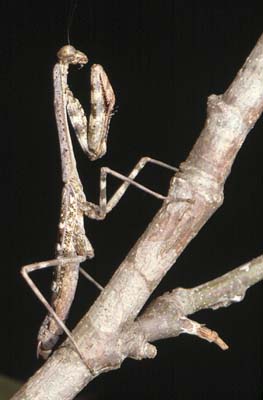
Adult Carolina mantid, Stagmomantis
carolina.
(Photographer: James Castner,
University of Florida)
Male and female mantids of the same species are similar in appearance, except that the abdomen of females is distinctly wider. These insects can be as large as 10 cm in length. The heads of mantids are triangular in shape, and the combined length of the head and thorax is as long as the abdomen. The wings of mantids are leathery and do not extend all the way to the tip of the abdomen. Mantids have the ability to rotate their head 180 degrees. These insects vary in color from green, grayish brown, brown, to pale green in color. The most distinguishing feature of these insects is their raptorial forelegs which have long spines on the upper and inner surfaces. These legs, which are used to grasp their prey, are held in front of the body and folded under their head.
The female lays 12 to 400 eggs in a frothy liquid that eventually hardens to form a protective shell. This is called an ootheca, or egg case. Oothecae are usually light to dark brown in color. Nymphs resemble mature adults in that they are soft-bodied, possess the same coloring and shape (only in a smaller form), but lack wings. Older nymphs possess wing pads. Nymphs hatch in the spring, and reach maturity by mid-summer.
Mantids are found throughout the United States in meadows and gardens, on herbs, shrubs, flowers and other foliage, on buildings and on fences.
Mantids are voracious predators that feed on butterflies, aphids, moths, crickets, flies, small wasps, bees, true bugs, caterpillars and even other mantids.
Images
To save the Web-optimized images shown below to your hard drive:
|
Click to access Display and Print quality images. |
|
Click to access Display and Print quality images. |
|
Click to access Display and Print quality images. |
|
Click to access Display and Print quality images. |
|
Click to access Display and Print quality images. |
|
Click to access Display and Print quality images. |
|
Click to access Display and Print quality images. |
|
Click to access Display and Print quality images. |